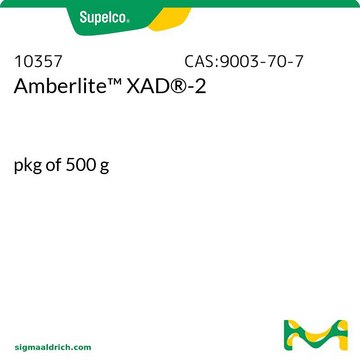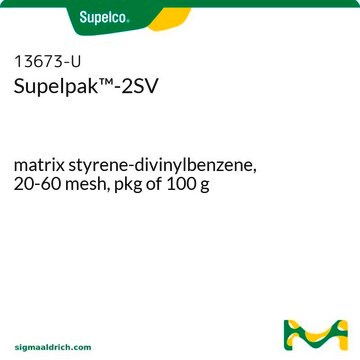13674-U
Supelpak™-2SV polymeric adsorbent
matrix styrene-divinylbenzene, 20-60 mesh, pkg of 1000g
Sinonimo/i:
xad-2
Autenticatiper visualizzare i prezzi riservati alla tua organizzazione & contrattuali
About This Item
Codice UNSPSC:
23151817
NACRES:
SB.52
Prodotti consigliati
Nome del prodotto
Supelpak™-2SV, matrix styrene-divinylbenzene, 20-60 mesh, pkg of 1000 g
Stato
beads
Confezionamento
pkg of 1000 g
tecniche
LPLC: suitable
Area superficiale
~300 m2/g
Matrice
styrene-divinylbenzene
Gruppo funzionale matrice
polymer
Dimensione particelle
20-60 mesh
Dimensione pori
~0.65 mL/g pore volume
90 Å mean pore size
applicazioni
environmental
Tecnica di separazione
reversed phase
Cerchi prodotti simili? Visita Guida al confronto tra prodotti
Applicazioni
- Supelpak™-2SV resin was used as column packing material to extract sesquiterpenes.
- Supelpak™-2SV resin was used in glass column as packing material to capture limonene.
- Supelpak™-2SV resin was used as packing material to capture the off gas for NMR analysis.
- Used as adsorbent in the extraction of organochlorine compounds by Soxhlet extraction technique
- Adsorbent in the extraction of honey samples using column chromatography for HPLC analysis
- Used in adsorption chromatography
Note legali
Supelpak is a trademark of Sigma-Aldrich Co. LLC
Codice della classe di stoccaggio
11 - Combustible Solids
Classe di pericolosità dell'acqua (WGK)
WGK 3
Punto d’infiammabilità (°F)
Not applicable
Punto d’infiammabilità (°C)
Not applicable
Scegli una delle versioni più recenti:
Possiedi già questo prodotto?
I documenti relativi ai prodotti acquistati recentemente sono disponibili nell’Archivio dei documenti.
Engineering cyanobacteria for the production of a cyclic hydrocarbon fuel from CO2 and H2O
Halfmann, Charles, Liping Gu, and Ruanbao Zhou
Green Chemistry, 16, 3175-3185 (2014)
Sean A Agger et al.
Journal of bacteriology, 190(18), 6084-6096 (2008-07-29)
Cyanobacteria are a rich source of natural products and are known to produce terpenoids. These bacteria are the major source of the musty-smelling terpenes geosmin and 2-methylisoborneol, which are found in many natural water supplies; however, no terpene synthases have
Grayson T Wawrzyn et al.
Methods in enzymology, 515, 83-105 (2012-09-25)
Fungi produce a myriad of terpenoids with a broad range of biological activities, many of which can be adapted to human use. This requires knowledge of the enzymes responsible for the biosynthesis of these compounds. Herein, we describe strategies for
Il team dei nostri ricercatori vanta grande esperienza in tutte le aree della ricerca quali Life Science, scienza dei materiali, sintesi chimica, cromatografia, discipline analitiche, ecc..
Contatta l'Assistenza Tecnica.








